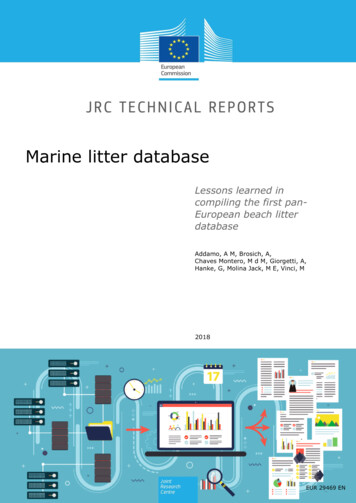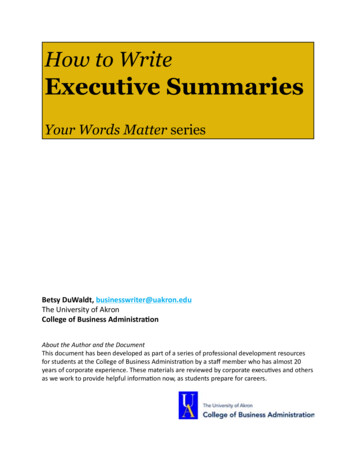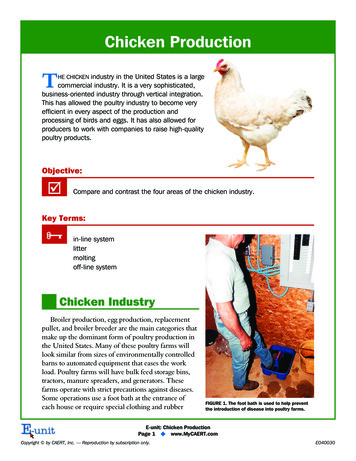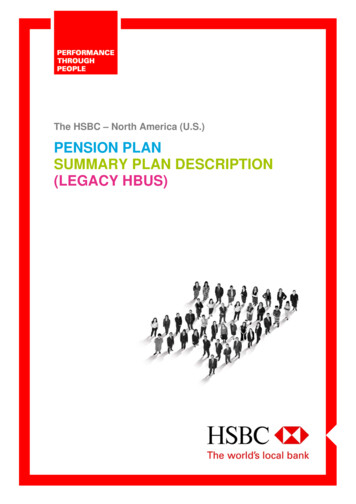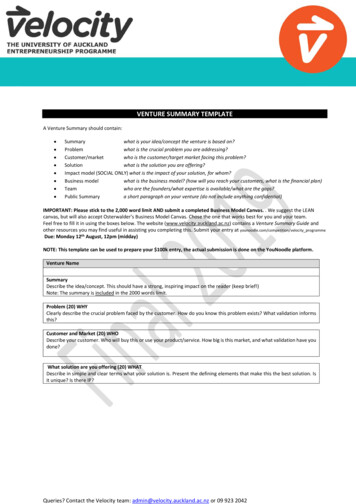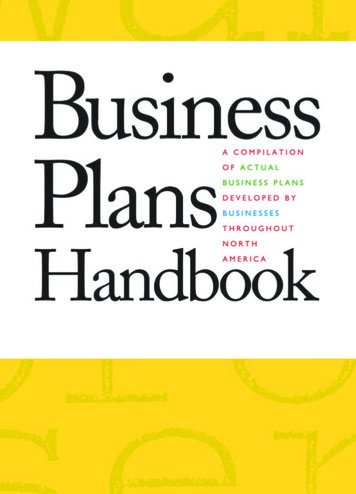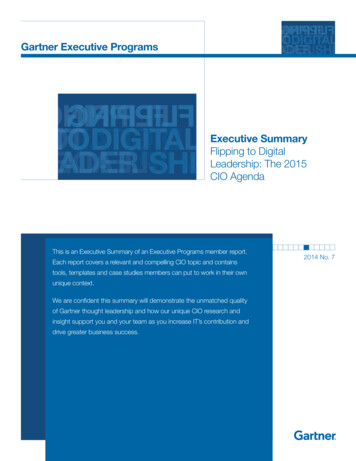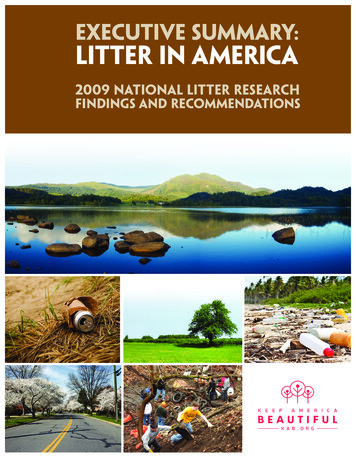
Transcription
executive summary:litter in america2009 national litter researchfindings and recommendations
EXECUTIVE SUMMARYLitter in America: National Findings and RecommendationsP. Wesley Schultz, California State UniversitySteven R. Stein, Environmental Resources Planning LLCKeep America Beautiful (KAB) is a non-profit organization dedicated to communityimprovement through litter prevention, waste reduction/recycling, and beautification. KAB wasfounded in 1953 and has grown into the nation’s leading community involvement organization,with more than 1,200 local affiliates and participating organizations. Much of the litterprevention work completed by KAB and its affiliates is based on seminal research conducted inthe 1960s and 1970s about the sources and causes of litter.In an effort to update and advance the research foundation for their litter preventionactivities, KAB funded a series of studies in 2008 and 2009 with financial support from PhilipMorris USA, an Altria Company. These studies focused on two broad topics: litter and litteringbehavior. With regard to litter, the research team explored the composition of litter acrossAmerica: its volume, locations and costs to local communities and businesses. With regard tolittering behavior, the research team explored how often people litter, the individual andcontextual variables that contribute to littering, and the effectiveness of various approaches toreducing littering rates.Technical reports from these two sets of studies are available through the KAB website(www.kab.org/research09). In this integrated executive summary, we summarize the basicmethodology and results from the two funded studies, highlight key findings, and offerrecommendations for ways to integrate these findings into litter prevention activities.1. Litter: Sources, Characterization and CostsThroughout this summary, we differentiate between litter (the item) and littering (thebehavior). Litter is any piece of misplaced solid waste, and it can range in size from tiny bits ofpaper to large appliances and automobiles. While litter accumulates in all areas of the country,roadways are a particular focal point. Across the country, there are about 3.8 million miles ofroadway, maintained by national, state, county, and municipal entities. To estimate the amount oflitter along roadways, the research team selected a random sample of 240 roadway segments,stratified by type and by rural/urban areas. In each segment, a sample area of 300 x 15 feet wasidentified along the side of the roadway. Observations were then made of littered objects of 4 inches within the sample site. Separate observations were made within a 15 x 15 foot subarea forlittered objects less than 4 inches.Using the percentage of found litter in their random national sample, the researchers wereable to statistically weight and estimate the amount and types of litter across all roadways. Theirresults indicate that there are 51.2 billion pieces of litter on roadways nationwide; and of this, themajority (91%, or 46.6 billion pieces) is less than four inches. This estimate translates into 6,729pieces of litter per mile of roadway (on each side).1
The characterization of litter (of all sizes) is shown in Figure 1 below. As shown, themost frequently counted littered items were tobacco products (38%), which were predominantlycigarette butts. Paper (22%) and plastic (19%) comprise the next largest types of materials.Figure 1: Aggregate Composition of Litter, All U.S. RoadwaysEach item of observed litter was also coded into a likely source. As might be expected,the majority of roadside litter was attributed to motorists (53%). However, a sizeable percentagewas attributed to pedestrians (23%), improperly covered loads (16%), debris from the vehiclesthemselves (2%), and spillage from receptacles in the surrounding vicinity (1%).Historically in studies of litter, there has been a specific emphasis on beverage containers.The current estimates project a total of 1.4 billion beverage containers on our nation’s roadways(3% of all litter). While the majority of these containers are beer (30%) and soft drinks (25%),there has been a growth in the number of water (6%) and sports drinks (3%).Multi-linear regression analyses were performed of site attributes that correlated with thequantity of observed litter. Key findings included: Residential areas were 40% less littered than roadways in general.Locations near loading docks were 29% less littered.Roadways near convenience stores were 11% more littered.Roadways near commercial establishments were 11% more littered.Solid waste and recycling facilities were associated with less litter than averagewithin 1 mile, but more litter for 2-5 miles. This effect increased as the number offacilities increased.2
The methodology used in the 2009 study allowed for comparisons to a 1969 nationallitter study, also funded by KAB. Several significant conclusions can be drawn when comparingthe 1969 and 2009 litter surveys: The actual count of overall litter is down by 61% since 1969. This decrease, a result of successful education, ongoing cleanup efforts and changes inpackaging, is reflected in dramatic reductions of paper, metal and glass litter since 1969. Plastic litter has increased by 165% since 1969.Figure 2: Change in Litter Since 1969The results from these comparisons suggest that litter along roadways, at a national level,decreased by 61% between 1969 and 2009. The reductions are particularly noteworthy in metal(down 88%), glass (down 86%), and paper (down 79%). Reflecting the increasing use of plasticin packaging materials over the past 40 years ( 340% per capita, source: U.S. EPA), plastic litterhas predictably increased ( 165%).The study also sampled six types of non-roadway areas (180 sampling sites) using thesame coding methodology: transition points, storm drains, loading docks, recreation areas,construction sites, and retail sites. Of these, transition sites and storm drains were the mostlittered, though different litter characteristics were reported at all six types of sites. This isparticularly important given that litter near storm drains is likely to wash into local waterways,with potential for serious environmental contamination.3
The national costs of litter abatement were estimated using data collected from cities,counties, states, educational institutions, and businesses. Indirect costs were estimated withsurveys of real estate brokers, business development officers, property appraisers, andhomeowners. While some obstacles were reported in obtaining comparable data from the diversesources, the available data lead to a projected cost of 11.5 billion in annual litter clean-up andprevention. The bulk of this ( 9.1 billion) is incurred by businesses. This estimate is likely anunderestimate, given that many cleanup costs are buried in staff, maintenance and variousdepartmental budgets.In addition to the direct costs of litter, the team also explored the indirect costs of litter,particularly to property values and housing prices. The team cites other evidence indicating thatthe presence of litter in a community decreases property values by 7%. The reported data bearout the impact of litter on property values, as 40 percent of homeowners surveyed think that litterreduces home values by 10-24 percent, while 55 percent of realtors think that litter reducesproperty values by about 9 percent, and 60 percent of property appraisers would reduce a home’sassessed value if it was littered.2. Littering BehaviorThe second set of studies focused on individuals and their littering behaviors. We beginfrom the assumption that litter is caused by human behavior, whether intentional or accidental.To examine individual littering behaviors, the team conducted three studies: an observationalstudy, intercept interviews with observed litterers, and a nationwide telephone survey.Behavioral observations. In an effort to go beyond the typical self-report measures usedto study littering behavior, the research team developed a protocol for observing the disposalbehavior of individuals in public places across the country. Nearly 10,000 individuals wereobserved from 130 different locations in 10 states, with sites evenly split between rural, urbanand suburban. Locations included fast food, recreation, gas stations, city centers, rest stops,medical/hospital, bars/restaurants, convenience stores and retail. The majority of observationsfocused on general disposals (that is, any item). The team also conducted some additionalobservations focused exclusively on the disposal of cigarette butts.Each of the 130 sites was coded for refuse infrastructure and existing litter. Across the130 locations, 118 (91%) had at least one trash receptacle. However, ash receptacles wereconsiderably less common, and only 61 sites (47%) had an ashtray of any kind. Similarly,recycling containers were generally uncommon, and only 16 sites (12%) had at least onerecycling bin. Litter was common across the sites, and only two were litter free. The mostfrequently observed types of existing litter were cigarette butts, miscellaneous paper, and foodwrappers.Commensurate with the volume of litter, our team observed a high amount of litteringbehavior. Across the sites, our team unobtrusively observed the disposal behaviors of 9,757randomly selected individuals. Among these, there were 1,962 disposals -- 17% of which werelitter. That is, of the individuals we observed disposing of something while they passed throughthe site, 17% resulted in litter. The most frequently littered items were cigarette butts (57% of all4
cigarette butts were littered), along with food remnants and wrappers. These findings are shownbelow in Table 1. Contrary to expectations, 81% of the littering occurred with notable intent.Table 1: Type and Frequency of Disposed ObjectsItemCigarette ButtCombo/Mixed TrashPaperBeverage CupNapkin/TissueBeverage Bottle: PlasticFood RemnantsFood WrapperBeverage CanFood ContainerPlastic BagBeverage Bottle: 2% tical analyses using multi-level modeling examined the contextual and personalvariables that were predictive of littering. Contextual variables included aspects of the physicalsurroundings, such as availability of trash receptacles, existing litter, weather, and time of day.Personal variables were aspects of the individual, such as their age and gender, as well asmotivational variables like awareness, attitudes, and feelings of personal responsibility. Theresults showed that 15% of littering behavior was attributable to contextual demands, while 85%resulted from the individual. The strongest contextual predictors of littering rates included theavailability of trash receptacles (negatively), the distance to the receptacle at the time of disposal(positively), and the amount of litter already present (positively). At the individual level, age waspredictive of littering, with older individuals littering less than younger. Surprisingly, gender wasnot related to littering rates; males and females were equally likely to litter.A similar set of analyses was conducted on the disposal of cigarette butts. As withlittering in general, the majority of cigarette butt litter (62%) was attributable to personalvariables, while 38% was due to the contextual demands (primarily lack of disposalinfrastructure). Also consistent with the finding for general litter, availability and convenience ofash receptacles was predictive of littering, as was the presence of existing litter (of any type, notnecessarily cigarette butt litter).Intercept interviews. The team also conducted intercept interviews with 102 of theobserved individuals. While we did not confront the individuals who were observed littering, wedid ask questions about attitudes, motivation, and past littering behavior. Among the individualswe interviewed, 23% had just been observed littering. Of these observed litterers, 35% denied5
littering in the past month, despite the fact that we had just seen them do so. Across the full 102interviews, 43% reported littering in the past month. The most frequently reported items werecigarette butts, food wrappers and remnants, and paper. In comparing non-litterers to litterers, akey distinguishing difference was the reported personal obligation not to litter; individuals whowere observed littering were much less likely to report a personal obligation to not litter.National telephone survey. The results from the nationwide observations are compared tofindings from a random digit dialing telephone survey. A sample of 1,039 residents of the UnitedStates completed survey items about their past littering behavior, beliefs and norms aboutlittering, motivators and barriers for proper disposal, and demographics.In the current 2008 national survey, 15% of the sample reported littering in the pastmonth. By comparison, a 1968 national telephone survey using a nearly-identical set of itemsfound a 50% admitted littering rate. This finding speaks to the dramatic drop in littering and theincrease in social disapproval of littering over the past 40 years.While the overall reported frequency of littering is small, the most commonly reporteditems were cigarette butts, food remnants (apple core or banana peel), and confectionsRespondents reported littering more when: the item was biodegradable, the item was notrecyclable, no trashcan was nearby, and when they were in a hurry. Community appearance wasassociated with littering rates, whereby respondents were less likely to report littering into clean,attractive, and beautified areas.3. Key FindingsThe research findings described in this executive summary and detailed in the twotechnical reports available through the KAB website, support a number of conclusions andrecommendations. Below we highlight four key findings from across the studies.A. Litter and littering has decreased in the past 40 years, but it remains an importantproblem. In the litter characterization study, visible roadside litter was found to have decreasedby about 61% since 1968. Similarly, the results from the nationwide telephone survey showedthat 15% of Americans reported littering in the past month, down from 50% in 1968.Yet despite these marked reductions, litter remains an important problem. Nationwide,our research estimates that there are 51.2 billion pieces of litter on our nation’s roadways, and thelarge majority of this litter is less than 4 inches. The nationwide observations showed a nationallittering rate of 17% -- that is, of all the disposals that take place in public places (at least, thetypes of places we observed), 17% result in litter.B. The cost of litter is substantial. Litter has a number of negative consequences,including substantial costs to business and government, and reduced property values. Estimatesfor the cost of litter show that 11.5 billion are spent on abatement and clean-up activities eachyear, and this number probably underestimates the true costs.C. Preventing litter—the person. The cumulative results from both sets of studies clearlyindicate that individuals are the key source of litter. In fact, the observational results found that6
81% of observed littering acts were intentional. Similarly, the litter characterization studyestimated that more than 90% of litter found at transition points could be traced back to anindividual’s disposal decision. Our estimates show that as much as 85% of littering behavior canbe attributed to the individual (and conversely, 15% to the context).Two important person-level variables emerged from our analyses. The first is age, where weconsistently find that younger individuals are more likely to litter (and report littering) than olderindividuals. This group presents a clear market segment for focused messaging and campaigns.But going beyond the passive media and messaging campaigns, the finding also highlights theneed to actively involve youth in clean-up and beautification activities. Involving individuals inclean-up activities can help to raise their awareness about litter as an issue, and to increase theircommitment to prevent litter. A second variable that emerged from our findings is a personalobligation to not litter. Individuals who hold the belief that littering is wrong, and consequentlyfeel a personal obligation not to litter, are less likely to do so (both in their self-reports, and intheir observed littering rates).D. Preventing litter—the context. While it’s tempting to focus exclusively on theperson as a source of litter, our research clearly shows that littering is a function of both theperson and the context. Consequently any effort to reduce litter and littering needs to focus onboth.One of the strongest contributors to littering is the prevalence of existing litter. Consistentlyin our results, we find that litter begets litter. Individuals are much more likely to litter intolittered environments (as seen in the observational studies), and they are less likely to reportlittering into beautified environments (from the telephone survey). These findings stronglysupport the need for ongoing clean-up and beautification efforts. Indeed, posting litter preventionmessages or signs in already-littered environments is likely to exacerbate the littering problem,rather than fix it.4. Next StepsThe cumulative results from the research reported in this summary provide a foundation forthe next generation of litter prevention activities. In the short section below, we sketch fourbroad areas of work and next steps.A. Areas for new partnerships. Corporate sponsors have been an ongoing source of supportfor Keep America Beautiful and its affiliates. While the results from our research show that thesepartnerships have been fruitful, it also points to industries and materials that constitute asignificant portion of litter and thus, a responsibility to support KAB’s efforts going forward.1) Plastics. The results from the nationwide study of visible litter show a dramatic increasein the amount of plastic litter. This shift highlights a change in consumer materials, aswell as packaging practices.2) Recyclables. In the early days of litter prevention, the focus was on placing and installingtrash receptacles. The current data show that trash receptacles are quite common in publicspaces across the country (91% of the public spaces observed by our team had at leastone receptacle). But recycling containers are far less common, and there is evidence that7
people have a heightened interest in properly disposing of recyclable materials.Recyclable items, particularly paper items, were found to be a noteworthy portion ofroadside litter and offer an opportunity to both reduce litter and increase recycling rates atthe same time.3) Cigarette butts. Across all of the data collected in this project, cigarette butts were themost frequently found pieces of litter, and they were the most frequently littered item.4) Confections. In both the observational study and the survey of visible litter, confectionsemerged as a source of litter.5) Waste haulers. Trash and recycling collection vehicles have been found to be a source oflitter. When improperly secured during collection and delivery to disposal facilities, thesevehicles can contribute to the litter problem, particularly of smaller items. Developing aprogram in partnership with hauling stakeholders can help to reduce roadside litter.B. Messaging. Given the results showing the central role of the person in producing litter, werecommend developing a consistent set of messages to be used across various media and litterprevention communications. The results from our research will be instructive for informing suchmessages, but more importantly, they also suggest strategies to avoid. First, we find no evidencefor gender differences in littering rates, and based on these findings, targeting one gender overanother seems unwarranted. Second, there is a clear connection between littered environmentsand littering behavior. The presence of litter conveys a norm that littering is acceptable. Thus,messages that depict litter-strewn environments or images of individuals littering — even whensuch messages are accompanied by a message that littering is wrong — are inadvisable. Thestronger message is one that emphasizes a clean environment, beautification, and the generalcommunity norm against littering.C. National litter prevention campaign. The findings from our research indicate that litterand littering remains an important national issue. But the results also show that change ispossible, and that both litter and littering have decreased over the past 40 years. To this end, werecommend conducting a multi-year, national litter-prevention campaign. The campaign shouldbe conceived at the national level, but implemented locally through affiliates and partnerorganizations. The campaign should focus on both contextual and personal variables. At thecontextual level, important elements should include: providing available and convenientreceptacles, regular and ongoing community clean-ups, and a focus on beautification practicesthat encourage people not to litter. At the personal level, the campaign should provide media andoutreach materials that emphasize clean communities, general social disapproval for littering,and an individual’s personal obligation to not litter.D. Continued monitoring. Given the large network of KAB affiliates and partneringorganizations, we recommend coordinated data collection and monitoring of both litter andlittering. These efforts could include a consistent and integrated system for collecting, coding,and aggregating both accumulated litter, and littering behaviors in communities across thecountry. In addition, we see value in developing a uniform reporting mechanism for KABaffiliates about the costs of litter that can be rolled up at the national level. And finally, werecommend a data analytic and reporting plan that makes use of this national dataset to trackchanges in litter, evaluate and inform campaign and program activities, and examine the effectsof litter at both the local and national levels.8
In closing, we want to emphasize the importance of focusing on local contexts. While theresults from the reported research provide a window into litter and littering behavior in America,there was considerable variability across the country. These findings and recommendations willbe useful to structure a national-level program and campaign, but we want to emphasize thatlittering is primarily a local issue.The national-level agenda can help to guide and structure litter-prevention efforts, but theseactivities need to be implemented locally. With its network of more than 1,000 affiliates andparticipating organizations, Keep America Beautiful is well-positioned to coordinate a nationallevel campaign with local involvement. In conducting this work, it will be important for localorganizations to understand the motivational and structural barriers that exist within theircommunities, and to devise intervention strategies that are tailored to meet their needs. Theresearch summarized here can provide an excellent starting point, and the national-level findingscan help to frame and bring focus to the work. But it is the commitment of local organizations,communities, and ultimately individuals, working in partnership with Keep America Beautifulthat will bring an end to litter.P. Wesley Schultz, Ph.D.California State UniversitySteven R. Stein, PrincipalEnvironmental Resources Planning LLC9
Keep America Beautiful (KAB) is a non-profit organization dedicated to community improvement through litter prevention, waste reduction/recycling, and beautification. KAB was founded in 1953 and has grown into the nation’s leading community involvement orga
